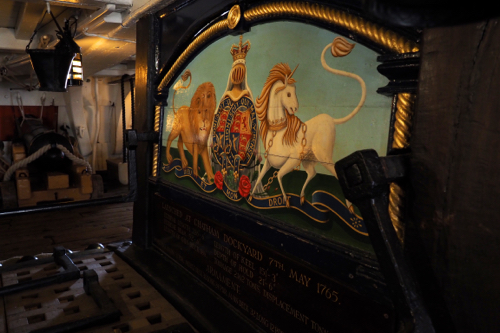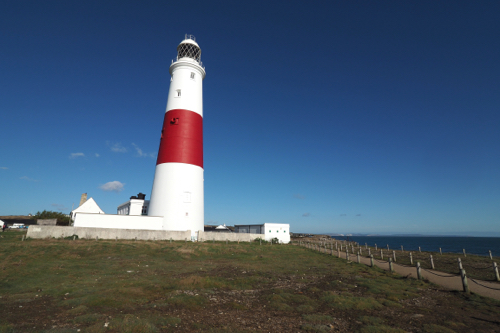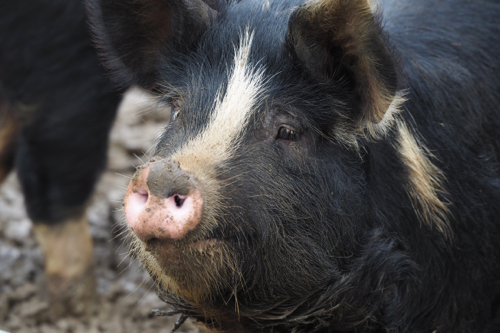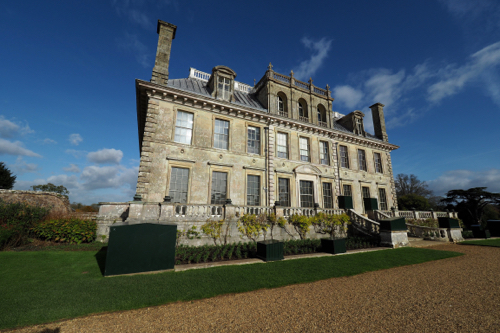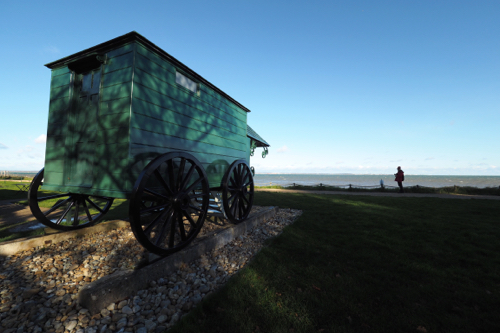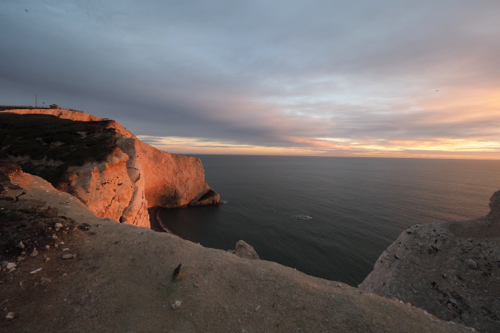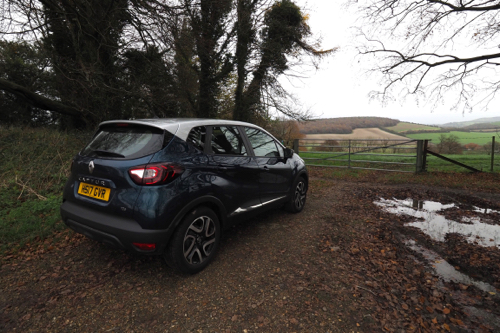November 6, 2017. Highbury, Greater London to Burton Bradstock, Dorset, United Kingdom.
After a coffee, pastry and an excellent fresh orange juice, at a nearby café (It was outrageously expensive at our hotel) we headed to Burton Bradstock to stay with our friends Pat and Graham.
For some unknown reason the TomTom took us right through the centre of London.
We had a break in Bournemouth and then continued on.
It took us most of the day and we didn’t arrive until after 5pm. This was partly due to the fact that we couldn’t find Pat and Graham’s house.
The last time we visited was in the summer of 2012 and it was very light in the evenings.
Now it was pitch black and we couldn’t recognise anything.
Added to that our travel phone didn’t have coverage in the area.
Thea went into the local pub for directions but they were in the middle of renovations and there were no locals there to help, only tradies.
One of the painters lent Thea his phone and we made contact with Pat and Graham and got directions from them.
November 7, 2017. Burton Bradstock, Dorset, United Kingdom and Portsmouth Dockyards.
Pat and Graham had arranged for us all to visit the Portsmouth Historic Dockyards. The dockyards are part of HM Naval Base in Portsmouth and managed by the National Museum of the Royal Navy.
The museum in Portsmouth was first opened in 1911 and houses many artefacts including historic buildings and the warships HMS Victory and HMS Mary Rose.
HMS Victory is best known as being Lord Nelson’s flagship at the Battle of Trafalgar in 1805. Built in the Chatham Dockyards in 1759 and launched in 1765, she was moved to a dry dock in Portsmouth in 1922.
It was on the Victory that Vice Admiral Horatio Lord Nelson was fatally shot. There is a spot on the deck that marks the exact place where he fell. On that day the Victory lost 57 men and another 102 were injured.
HMS Mary Rose is a Tudor-era warship built during the reign of King Henry VIII. Laid down in 1510 and launched in 1511 she saw action against in France, Scotland and Brittany.
She was sunk in the Solent, near the Isle of Wight in 1545, while leading the attack on the galleys of the French invasion fleet.
The Mary Rose was discovered in 1971 and salvaged in 1982. The exhibit, which is housed in a large building, contains thousands of artefacts that were recovered after she was raised.
November 8, 2017. Burton Bradstock, Dorset, United Kingdom and Isle of Portland.
This was the first clear sky day in some time and we were off on another adventure, this time to the Isle of Portland.
Portland is just off the Dorset coast, near Weymouth, and joined to the mainland by the Ferry Bridge.
The main significance of Portland lies beneath surface.
Portland Stone has been used in many famous buildings in both England and around the world. Buckingham Palace (1850), St Paul’s Cathedral (1675), the Palace of Westminster (1347), Tower of London (1349) and London Bridge (1350) as well as the United Nations headquarters in New York (1952).
The stone from Portland has been used as a building material since Roman times and was being shipped to London in the 14th century.
Pat and Graham, like Thea and me, enjoy walking, so no sooner had we arrived than we set of on the historic Portland Island walk.
Our first stop was the Portland Bill Lighthouse. Built between 1903 and 1905, its light warns passing ships of the hazardous Portland Bill. This narrow promontory is at the southernmost point of Dorset, a coastline that’s famous for the number of ships that have come to grief there.
We walked along the coast and then to Yeates Incline and the Merchant Railway. The railway, started in 1826, was designed to move Portland stone from the quarries to the coast for shipping. It was originally powered by horses but later replaced by the steam engine.
Then we found the Tout Quarry Sculptural Park, with its strange collection of free-standing and relief sculptures.
Our final stop was at St Georges Church which was built between 1754 and 1766. It was built to replaced the dilapidated St Andrews Church, which was Portland’s first parish church.
We ventured inside and were greeted by a very enthusiastic caretaker. He insisted that, as a visitor, I should ring the church bell.
He warned me not to hold on too tight as I might be taken up into the bell tower – he was right.
November 9, 2017. Burton Bradstock, Dorset, United Kingdom.
We decided to walk into West Bay from Burton Bradstock. This wasn’t along the road but over the fields. Graham described it as the ‘Trespass walk’ as we were illegally crossing some of his neighbours’ land.
No-one seems to care, as there were gates and tracks to make it easy.
In West Bay, Thea and Pat had a traditional ‘Cornish’ pasty for lunch. But it was really a ‘Dorset’ pasty, as we weren’t in Cornwall but Dorset.
Pat and Graham lead a very country life and part of that involves keeping pigs in their back yard. The pigs are collectively owned and cared for by the villagers of Burton Bradstock.
They aren’t pets but food.
Each year the village decides what breed of pig to keep and at the end of the year they are slaughtered and butchered. This keeps everyone in enough pork for the following twelve months.
This year’s breed was an Iron Age and Berkshire cross. They were due to be ‘realised’ in the next few weeks and Graham was frantically trying to find a butcher. It was getting towards Christmas and they were all booked up.
Obviously they weren’t the only village in the area to have livestock it seemed.
November 10, 2017. Burton Bradstock, Dorset, United Kingdom and Kingston Lacy House.
After the more relaxing time we had the previous day we were back to exploring English history.
Graham had booked for us to do a tour of Kingston Lacy House – that didn’t eventuate.
When we arrived, the car park was filling up with people, so we just followed the crowd and joined in. This turned out to be the Kingston Lacy National Trust walk, not a tour of the house.
It took us through part of the estate and the surrounding area. The grounds consist of 164 hectares of gardens and 159 hectares of park and ornamental land.
It turned out to be a good mistake, as the guided walk was interesting and gave us some more exercise.
In the afternoon we then did a tour of the house.
Kingston Lacy is a National Trust stately home, built in 1662, it was for many years the home of the Banks family. Between 1835 and 1838 the explorer and adventurer, William John Banks (1786 – 1855) extensively renovated Kingston Lacy. He faced the original brick with stone, added a chimney at each end and lowered the entrance to the basement level to create a new, grander, portal.
Within the house was ‘Exile’ an exhibition about the LBGT movement, William John Bankes and Kingston Lacy House.
Banks was an avid collector and a student of ancient Egypt. He was also gay, which was illegal at the time.
In 1841 Banks was exiled from England due to homosexual indiscretions, having been caught in compromising circumstances with a guardsman in Green Park, London.
Sodomy was punishable by death so exile was his only option.
Unable to return to Kingston Lacy, Banks continued to collect art and commission great works, which were then sent back to the house.
His last 14 years were spent in Europe, although it is believed that he did return from time-to-time to inspect his beloved home.
November 11, 2017. Burton Bradstock, Dorset to Newport, Isle of Wight, United Kingdom.
After a very pleasant few days we left Pat and Graham and headed off again.
It was just under two hours from Burton Bradstock to the ferry terminal in Southport.
The TomTom told us it would be 90 minutes. It obviously wasn’t aware of the long queue of Saturday shoppers heading to Ikea, which was just near the docks.
When we arrived in Newport we didn’t do much, just wandered around and got a feeling for the town.
The area was occupied at least 40,000 years ago by Neanderthals. There are also signs that the Romans were there as well.
After the Norman conquest the French burnt down most of the town in 1377. This was while trying to take Carisbrooke Castle.
November 12, 2017. Newport, Isle of Wight, United Kingdom.
On the Isle of Wight we stayed in the Wheatsheaf Hotel in Newport. This former coaching inn, built in 1693, is in the heart of the old town and opposite the Minster Church of St Thomas that was built in 1854.
Even though it was November 12, not 11, the Brits we’re celebrating Remembrance Day.
Apparently they celebrate on the Sunday that’s closest to the 11th.
Straight backs, firm jaws and stiff upper lips were everywhere on both the men and women.
They were all proudly displaying their medals.
The main excursion for the day was to see Osborne House.
Built between 1845 and 1851, Osborne House was the holiday home of Queen Victoria and Prince Albert.
It was here that they raised their children, entertained their friends, relaxed and escaped from court life.
Prince Albert designed the house himself in the style of an Italian Renaissance Palazzo. He even built a replica Swiss chalet to remind himself of his childhood.
Much of the house’s furnishings were paid for from the proceeds of the selling the Royal Pavillion in Brighton.
There is a big connection to the British Raj and India, especially in the Durbar Room. Built for state functions, it was decorated by Bhai Ram Singh, one of Punjab’s formost architects. The room even has an Indian carpet from Agra.
In 1901 Queen Victoria died at Osborne house and after her death the house was given to the state.
The Governor General’s residence in Melbourne, Victoria is said to have been styled after Osborne House.
You can see the similarity.
Before exploring the house we wandered around parts of the gardens, even down to the private beach. Here Queen Victoria, Prince Albert and the children would swim from bathing machines. Queen Victoria’s bathing machine is still on the beach.
Bathing machines were part of the Victorian etiquette for sea bathing. They allowed the bather to change into their swimming costume and enter the water without any hint of skin.
The beach and bathing machine were only opened to the public in 2012.
November 13, 2017. Newport, Isle of Wight, United Kingdom.
The Isle of Wight isn’t very big, only 384 square kilometres, so we decided to drive around.
It was owned by a Norman family until 1293 and before that it was an Anglo-Saxon settlement. And even before that, the Romans settled there in 44BC.
We discovered the Brading Roman Villa, which was established between the 1st and 4th Centuries AD.
It was discovered in 1879 by Mr Munns, a local sheep farmer. Excavations started in 1880 with one of the most exciting finds being the mosaics. There are five on display, which are now protected by a contemporary museum and visitor’s centre that has been built over the site.
We were about half way through the exhibition when a guide turned up and insisted on showing us the rest.
This was fine, except that he then proceeded to tell us that most of what we had already read was wrong.
Recent finds had disproved most of what was written there.
There was also an exhibition of Japanese woodcuts from the 19th century, titled; Japanese Ghosts and Demons.
We drove to the most south west point of the Island to catch a glimpse of the Needles at sunset. The Needles are a distinctive row of 30 meters high chalk stacks at the very western part of the Isle of Wight.
The name ‘Needles’ comes from one of the rock formations known as ‘Lot’s Wife’ which collapsed after a storm in 1764. The remaining Needles don’t look like needles at all.
The Needles weren’t the only thing worth seeing as there was a vixen warily guarding her den. There was also a group of para gliders catching the updrafts from the white cliffs.
November 14, 2017. Newport, Isle of Wight to Winchester, Hampshire, United Kingdom.
We arrived in plenty of time for the 10:30 ferry to Southampton and were put on an earlier one, at 9:00.
Sometimes it pays to be punctual.
This left us with the rest of the day to explore the countryside around Southampton and Winchester.
Thea navigated around the area with the help of three GPS systems and an analog map.
It was a little confusing on some occasions when I was getting instructions from three different female voices.
We arrived at the King Alfred Pub in Winchester in the middle of the afternoon and checked in.
This was another traditional English establishment with old furniture and a large bar. There were many small rooms running off to the side.
We drove back into Winchester to see the famous Winchester Cathedral and have a brief wander around the old town area.
The Diocese of Winchester has a long history dating back to 650. The new cathedral was built in 1079 and is one of the largest Gothic cathedrals in Europe, with the longest nave and greatest overall length.
It had a brief revival of popularity in 1966 as a song by the novelty British pop group, The New Vaudeville Band.
Being nearly winter the days were short.
When we arrived back at the pub everything was dark and the door was locked.
There had been a flood in the ‘Gents’ and they had been forced to close for the night.
We were told not to worry, as their sister pub, the Green Man, was just a 15 minute walk away and we would get a discount if we ate there.
They even offered to get us a taxi.
The food was typical Pub Grub and the service shabby.
I think they had more guests than they had expected.
November 15, 2017. Winchester, Hampshire to Gatwick Airport, Crawley, West Sussex, United Kingdom.
After breakfast at the hotel and a coffee in Winchester we headed to Gatwick Airport.
The long way.
Travelling through the South Downs National Park. Opened in 2011, it is England’s newest national park, however there have been plans for its development since 1929. Bickering and interminable enquiries delayed it for that long.
When we reached Gatwick finding the Hertz drop off point wasn’t easy. The directions that came with the car were useless and we used three different GPS systems to work it out.
When we finally got there we complained, as I am sure others must have had a similar issue.
They didn’t really care.
Our last meal was at our hotel, the Hilton. It was ok but very expensive.
I much prefer the English pubs.
November 16, 2017. Gatwick Airport, Crawley, West Sussex, United Kingdom to JFK, New York City, New York State, USA.
We were up very early for our 6am flight to New York.
Our flight across the Atlantic was with Norwegian Air, and what a contradiction it was.
We were told that there wouldn’t be a meal service, and there was. We were told that their movies were great. There wasn’t any, not even a route map.
After a long wait at Howard Beach Station we caught the A Line to 125th Street, just around the corner from Ev and Steph’s place.
We were back in NYC.
